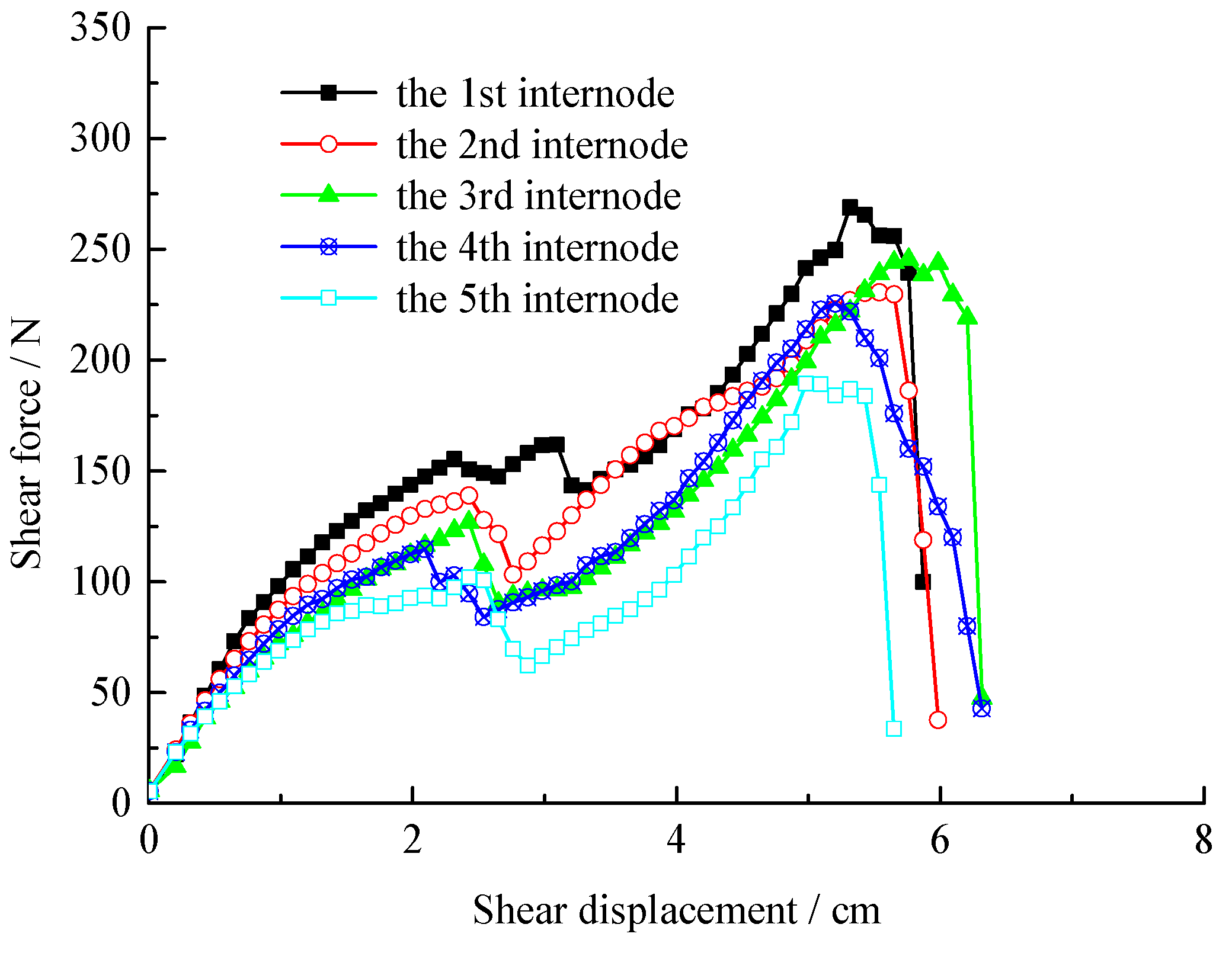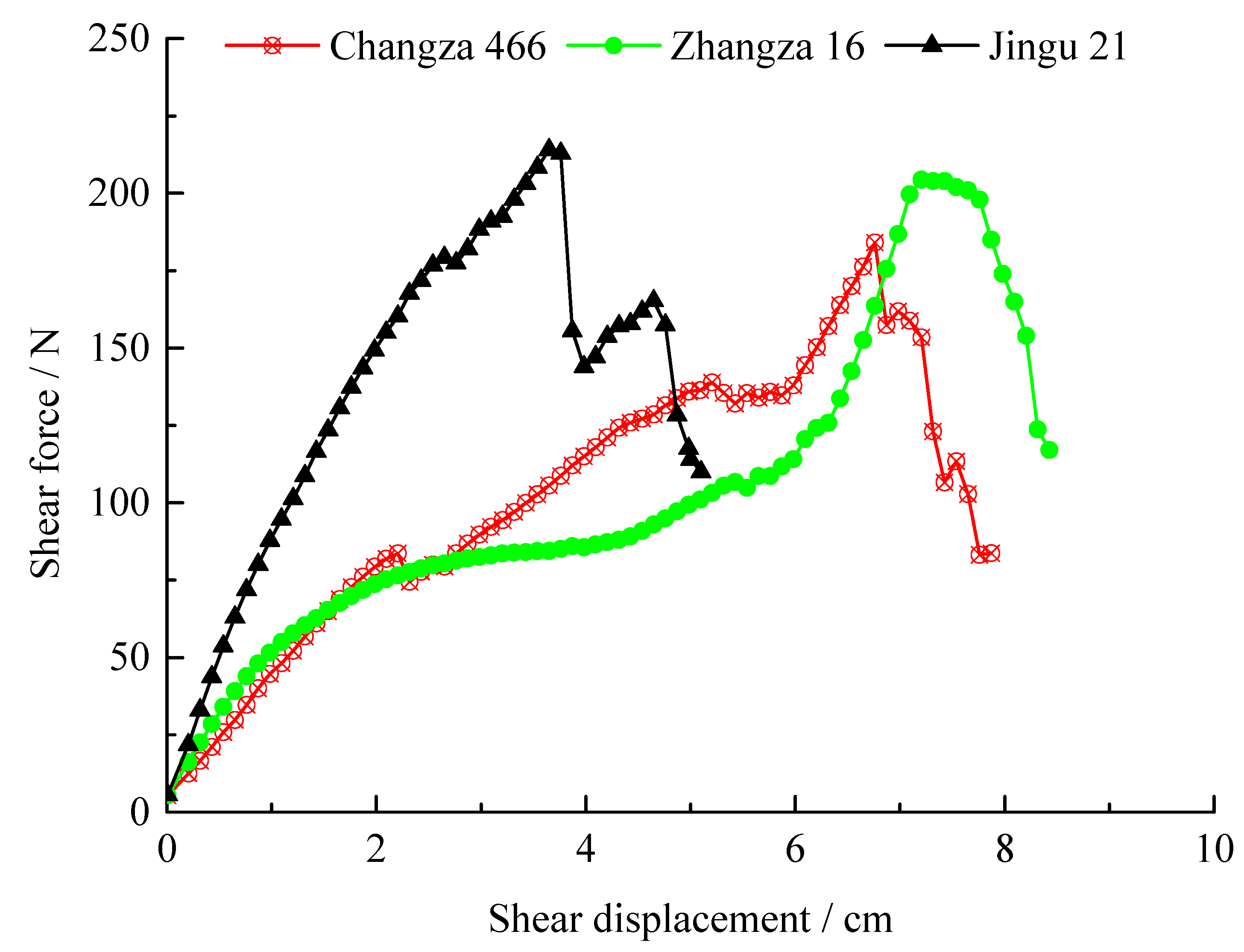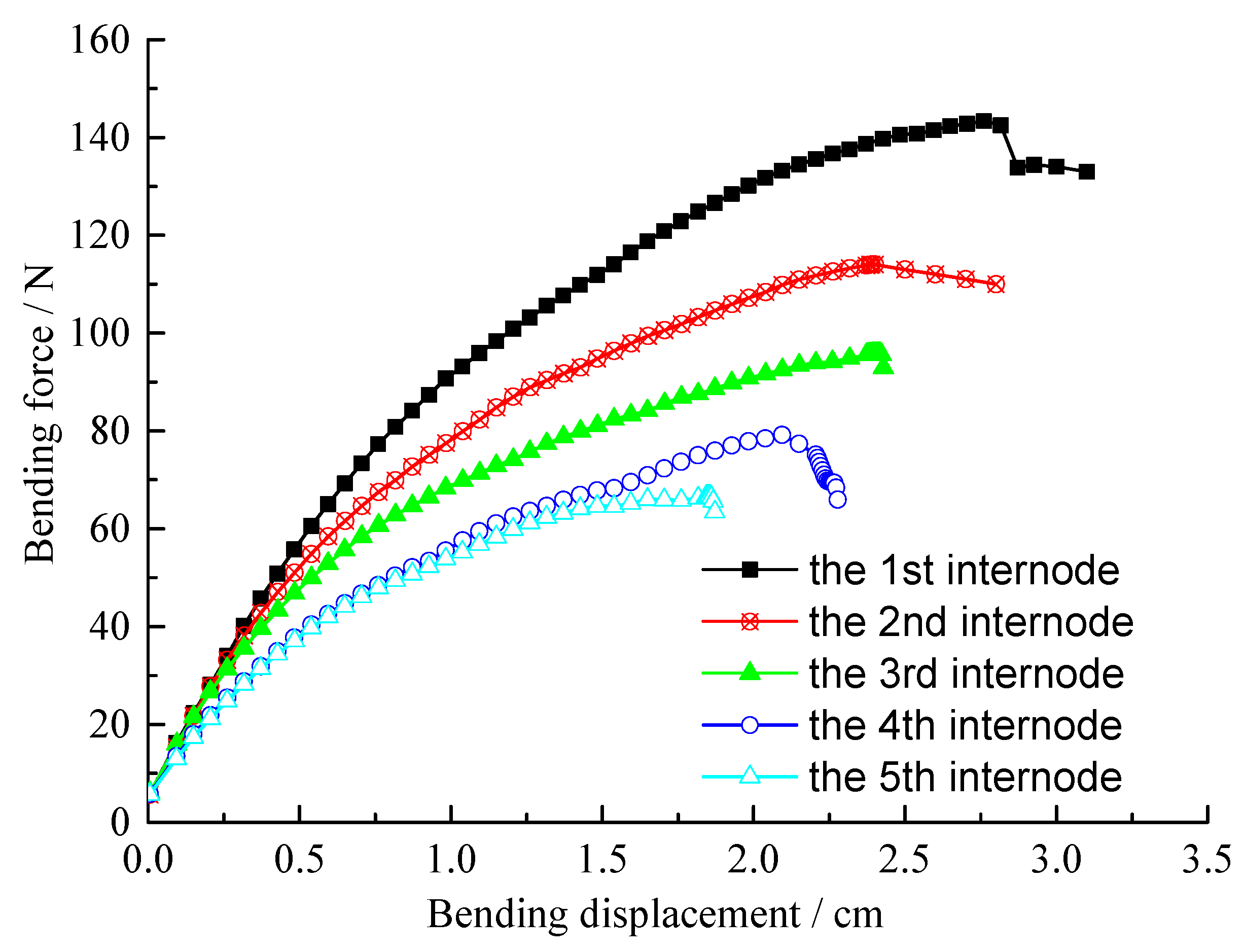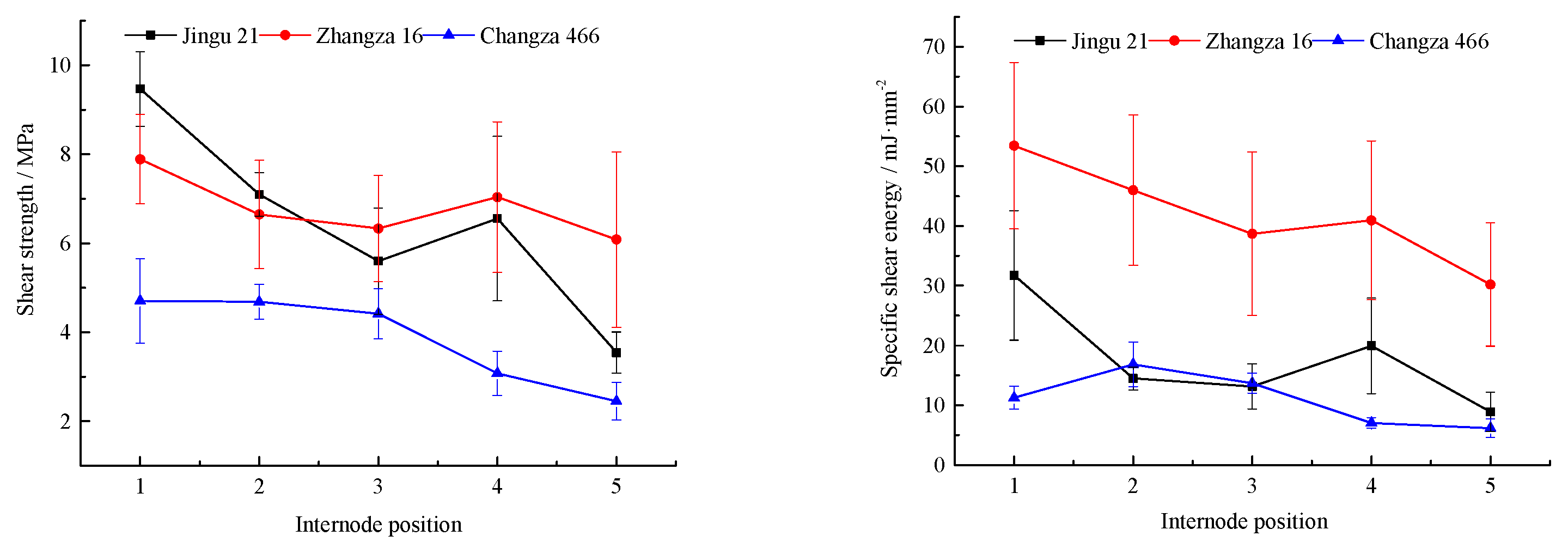Study on the Shear and Bending Mechanical Properties of Millet Stem
Abstract
1. Introduction
2. Materials and Methods
2.1. Experimental Materials
2.2. Experimental Instruments and Equipment
2.3. Experimental Methods and Data Processing
3. Experimental Results and Analysis
3.1. Mechanical Characteristics of Millet Stem Shear
3.1.1. Influence of Internode Position on Stem Shearing Force
3.1.2. Influence of Variety on Stem Shearing Force
3.1.3. Influence of Varieties and Internode Positions on Shear Parameters
3.2. Mechanical Characteristics of Millet Stem Bending
3.2.1. Influence of Internode Positions on Stem Bending Force
3.2.2. Influence of Variety on Stem Bending Force
3.2.3. Influence of Variety and Internode Position on Bending Parameters
4. Discussion
5. Conclusions
Author Contributions
Funding
Institutional Review Board Statement
Data Availability Statement
Acknowledgments
Conflicts of Interest
References
- Li, S.G.; Liu, F.; Zhao, W.Q.; Liu, M.; Xia, E.J.; Diao, X.M. The development history, integration models, and path selection for China’s foxtail millet seed industry. Res. Agric. Mod. 2023, 44, 32–43. [Google Scholar]
- Zhang, Y.Q.; Cui, Q.L.; Guo, Y.M.; Li, H.B. Experiment and analysis of cutting mechanical properties of millet stem. Trans. Chin. Soc. Agric. Mach. 2019, 50, 146–155+162. [Google Scholar]
- Liang, S.N.; Jin, C.Q.; Zhang, F.F.; Kang, D.; Hu, M. Design and experiment of 4LZG-3.0 millet combine harvester. Trans. Chin. Soc. Agric. Eng. (Trans. CSAE) 2015, 31, 31–38. [Google Scholar]
- Shah, D.U.; Reynolds Thomas, P.S.; Ramage, M.H. The strength of plants: Theory and experimental methods to measure the mechanical properties of stems. J. Exp. Bot. 2017, 68, 4497–4516. [Google Scholar] [CrossRef] [PubMed]
- Hone, T.; Mylo, M.; Speck, O.; Thomas, S.; Taylor, D. Failure mechanisms and bending strength of Fuchsia magellanica var. gracilis stems. J. R. Soc. Interface 2021, 18, 20201023. [Google Scholar] [CrossRef] [PubMed]
- Zeng, M.J.; Wang, M.; Cen, H.L.; Li, L.F.; Li, T.Y.; Jing, W.H.; Li, J.B.; Wen, B.Q. Experimental study on compression and rheological properties of stem of different licorice cultivars. J. Shihezi Univ. (Nat. Sci.) 2023, 41, 537–544. [Google Scholar]
- Wang, Q.; Lin, H.C.; Liao, P.; Wan, J.M.; Zheng, S.H. Shearing mechanical properties of tea stem. J. Fujian Agric. For. Univ. (Nat. Sci. Ed.) 2022, 51, 428–432. [Google Scholar]
- Ye, D.P.; Qing, J.X.; Lin, Z.Q.; Lai, H.K.; Weng, H.Y.; Xie, L.M. Experiment on mechanical characteristics of stem of “Oasis No.1” hole seedling. J. Chin. Agric. Mech. 2023, 44, 1–7+44. [Google Scholar]
- Liu, Q.T.; Qu, Y.G.; Qing, S.L.; Chen, H.B. Failure tests of sugarcane stalks under torsion, compression and tension load. Trans. Chin. Soc. Agric. Eng. (Trans. CSAE) 2006, 22, 201–204. [Google Scholar]
- Shahbazi, F.; Galedar, M.N. Bending and shearing properties of safflower stalk. J. Agric. Sci. Technol. 2012, 14, 743–754. [Google Scholar]
- Hou, J.M.; Bai, J.B.; Yang, Y.; Yao, E.C. Study and simulation analysis on curling mechanical properties of castor stem. J. Northeast Agric. Univ. 2018, 49, 69–78. [Google Scholar]
- Wang, B.A.; Dai, F.; Xin, S.L.; Zhao, W.Y.; Tian, B.; Zhang, Q.; Zhang, K.S. Test and analysis of cutting force of highland barley in mature stage. J. Gansu Agric. Univ. 2020, 55, 201–208. [Google Scholar]
- Yan, Y.X.; Zhao, S.H.; Yang, Y.Q.; Tian, B.L. Study in mechanics properties of soybean stems in mature stage. J. Northeast Agric. Univ. 2012, 43, 46–49. [Google Scholar]
- Boyda, M.G.; Omakli, M.; Sayinci, B.; Kara, M. Effects of moisture content, internode region, and oblique angle on the mechanical properties of sainfoin stem. Turk. J. Agric. For. 2019, 43, 253–263. [Google Scholar] [CrossRef]
- Xin, J.; Hou, J.L.; Li, Y.H.; Wu, Y.Q.; Wang, H.X.; Jiang, G.M. Experimental research on mechanical properties of garlic in mature period. J. Agric. Mech. Res. 2018, 40, 168–173+178. [Google Scholar]
- Liu, X.D.; Guo, W.B.; Wang, C.G.; Du, X.X.; Jin, M.; Wang, P.P.; Zhao, F.C. Research Status and Exploration of Mechanical Properties of Straw Materials. J. Agric. Mech. Res. 2019, 41, 265–268. [Google Scholar]
- Li, H.B.; Xue, J.X.; Wang, B.X.; Zhang, Y.Q.; Wu, X.H.; Li, X.B.; Cui, Q.L.; Yang, Z.M. Tensile properties of foxtail millet leaf sheath, leaf and leaf collar. Trans. Chin. Soc. Agric. Eng. 2020, 36, 11–17. [Google Scholar]
- Wang, B.X. Test and Analysis of the Binding Force among Stalk, Ear, Sheath, Leaf and Other Parts of Millet; Shanxi Agricultural University: Jinzhong, China, 2021. [Google Scholar]
- Zhang, L. Study on Tensile Mechanical Properties of Millet Stems and Fibers; Shanxi Agricultural University: Jinzhong, China, 2021. [Google Scholar]
- Tian, B.H.; Wang, J.G.; Zhang, L.X.; Li, Y.J.; Wang, S.Y.; Li, H.J. Assessment of resistance to lodging of landrace and improved cultivars in foxtail millet. Euphytica 2010, 172, 295–302. [Google Scholar] [CrossRef]
- He, Z.T.; Ding, H.L.; Li, J.; Zhang, Y.Z. Review of researches on stalk cutting. Mach. Des. Manuf. 2023, 61, 277–284. [Google Scholar]
- Zhang, Y.Q.; Cui, Q.L.; Xin, L.; Li, H.B.; Lai, S.T.; Liu, J.L. Variations and correlations of shearing force and feed nutritional characteristics of millet straw. Trans. Chin. Soc. Agric. Eng. 2019, 35, 41–50. [Google Scholar]
- Zhang, Y. Test and Study on the Harvest Time Correlation of Coarse Grain Crops; Shanxi Agricultural University: Jinzhong, China, 2020. [Google Scholar]
- Wu, C.Q.; Guo, Y.M.; Zhang, J.; Wu, X.H.; Wang, S. Research on bending mechanical properties and evaluation of lodging resistance of millet stem. Int. J. Eng. Tech. Res. 2017, 7, 13–17. [Google Scholar]
- Li, K.; Wang, Z.; Wang, Y. Effects of harvesting pattern and period on yield and quality of millet. J. Anhui Agric. Sci. 2023, 51, 36–38+58. [Google Scholar]
- Liu, L.; Shi, L.; Kong, F.T.; Wu, T.; Chen, C.L.; Sun, Y.F. Experimental research on mechanical properties of castor plants. J. Chin. Agric. Mech. 2023, 44, 14–19. [Google Scholar]
- Annoussamy, M.; Richard, G.; Recous, S.; Gua, J. Change in mechanical properties of wheat straw due to decomposition and moisture. Appl. Eng. Agric. 2000, 16, 657–664. [Google Scholar] [CrossRef]
- Li, X.C.; Liu, M.Y.; Niu, Z.Y. Test of shear mechanical properties of wheat stalks. J. Huazhong Agric. Univ. 2021, 31, 253–257. [Google Scholar]
- Tavakoli, H.; Mohtasebi, S.S.; Jafari, A.; Galedar, M.N. Some Engineering Properties of Barley Straw. Appl. Eng. Agric. 2009, 25, 627–633. [Google Scholar] [CrossRef]
- Wen, B.Q.; Li, Y.; Kan, Z.; Li, J.B.; Li, L.Q.; Ge, J.B.; Ding, L.P.; Wang, K.F.; Shi, Y.M. Experimental study on microstructure and mechanical properties of stalk for Glycyrrhiza glabra. J. Biomech. 2021, 118, 110198. [Google Scholar] [CrossRef]
- Wu, C.Q.; Li, N.; Zhang, S.; Wu, X.H.; Guo, Y.M. Experimental study on the biomechanical properties of millet stem. J. Shanxi Agric. Univ. (Nat. Sci. Ed.) 2016, 36, 377–380. [Google Scholar]
- Guo, Y.M.; Yuan, H.M.; Yin, Y.; Liang, L.; Li, H.B. Biomechanical evaluation and grey relational analysis of lodging resistance of stalk crops. Trans. Chin. Soc. Agric. Eng. (Trans. CSAE) 2007, 23, 14–18. [Google Scholar]
- Zuber, U.; Winzeler, H.; Messmer, M.M.; Keller, M.; Schmid, J.E.; Stamp, P. Morphological traits associated with lodging resistance of spring wheat (Triticum aestivum L.). J. Agron. Crop Sci. 1999, 182, 17–24. [Google Scholar] [CrossRef]
- Islam, M.S.; Peng, S.B.; Visperas, R.M.; Ereful, N.; Bhuiya, S.D.; Julfiquar, A.W. Lodging-related morphological traits of hybrid rice in a tropical irrigated ecosystem. Field Crops Res. 2007, 101, 240–248. [Google Scholar] [CrossRef]
- Shi, R.J.; Dai, F.; Zhao, W.Y.; Liu, Y.X.; Zhang, S.L.; Wei, W.C. Biomechanical properties test of flax stem. J. Chin. Agric. Mech. 2018, 39, 45–50. [Google Scholar]






| Variety | Internode Position | Average Outer Diameter (mm) | Internode Length (mm) |
|---|---|---|---|
| Jingu 21 | The 1st internode | 8.16 ± 0.58 | 67.56 ± 11.89 |
| The 2nd internode | 8.38 ± 0.34 | 73.71 ± 9.75 | |
| The 3rd internode | 8.06 ± 0.30 | 95.84 ± 17.40 | |
| The 4th internode | 8.03 ± 0.35 | 97.75 ± 10.97 | |
| The 5th internode | 7.78 ± 0.64 | 88.61 ± 28.85 | |
| Zhangza 16 | The 1st internode | 9.00 ± 0.20 | 55.52 ± 4.61 |
| The 2nd internode | 9.90 ± 0.76 | 52.53 ± 2.70 | |
| The 3rd internode | 9.50 ± 0.83 | 62.52 ± 7.24 | |
| The 4th internode | 8.45 ± 0.09 | 66.66 ± 1.33 | |
| The 5th internode | 8.26 ± 0.61 | 73.43 ± 8.11 | |
| Changza 466 | The 1st internode | 9.57 ± 0.17 | 63.09 ± 8.43 |
| The 2nd internode | 9.61 ± 0.18 | 63.31 ± 10.06 | |
| The 3rd internode | 8.93 ± 0.14 | 69.59 ± 15.74 | |
| The 4th internode | 8.77 ± 0.23 | 74.41 ± 22.56 | |
| The 5th internode | 8.09 ± 0.09 | 83.56 ± 16.38 |
| Variety | Internode Position | Shear Strength (MPa) | Specific Shear Energy (MJ/mm2) |
|---|---|---|---|
| Jingu 21 | The 1st internode | 9.472 ± 0.839 aA | 31.732 ± 10.825 aB |
| The 2nd internode | 7.096 ± 0.49 abA | 14.489 ± 1.935 bB | |
| The 3rd internode | 5.599 ± 1.197 bA | 13.163 ± 3.773 bB | |
| The 4th internode | 6.555 ± 1.852 bA | 19.946 ± 7.993 abB | |
| The 5th internode | 3.544 ± 0.459 cB | 8.916 ± 3.299 bB | |
| Zhangza 16 | The 1st internode | 7.888 ± 1.004 aA | 53.441 ± 13.942 aA |
| The 2nd internode | 6.648 ± 1.216 aA | 46.001 ± 12.561 aA | |
| The 3rd internode | 6.331 ± 1.200 aA | 38.696 ± 13.664 aA | |
| The 4th internode | 7.036 ± 1.695 aA | 40.953 ± 13.284 aA | |
| The 5th internode | 6.084 ± 1.972 aA | 30.202 ± 10.301 aA | |
| Changza 466 | The 1st internode | 4.703 ± 0.951 aB | 11.247 ± 1.918 bC |
| The 2nd internode | 4.683 ± 0.392 aB | 16.856 ± 3.735 aB | |
| The 3rd internode | 4.417 ± 0.564 aA | 13.708 ± 1.657 abB | |
| The 4th internode | 3.077 ± 0.499 bB | 7.042 ± 0.889 cB | |
| The 5th internode | 2.449 ± 0.422 bB | 6.172 ± 1.533 cB |
| Source of Variance | Freedom | Shear Strength | Specific Shear Energy | ||||
|---|---|---|---|---|---|---|---|
| Mean Square Error | F Value | p Value | Mean Square Error | F Value | p Value | ||
| Variety | 2 | 35.518 | 31.214 | <0.001 | 3955.412 | 56.244 | <0.001 |
| Internode Position | 4 | 13.093 | 10.611 | <0.001 | 346.283 | 4.924 | 0.004 |
| Variety * Internode Position | 8 | 2.838 | 2.3 | 0.047 | 85.103 | 1.21 | 0.327 |
| Error | 30 | 1.234 | 70.325 | ||||
| R2 = 0.804 | R2 = 0.825 | ||||||
| Independent Variable | Shear Characteristics | ||
|---|---|---|---|
| Shear Strength (MPa) | Specific Shear Energy (MJ/mm2) | ||
| Variety | Jingu 21 | 6.953 ± 2.208 a | 17.650 ± 9.819 b |
| Zhangza 16 | 6.797 ± 1.398 a | 41.860 ± 13.461 a | |
| Changza 466 | 3.866 ± 1.086 b | 11.010 ± 4.544 b | |
| Internode Position | The 1st internode | 7.354 ± 2.253 a | 32.140 ± 20.315 a |
| The 2nd internode | 6.142 ± 1.305 ab | 25.782 ± 16.579 ab | |
| The 3rd internode | 5.449 ± 1.224 b | 21.856 ± 14.509 ab | |
| The 4th internode | 5.556 ± 2.267 b | 22.647 ± 16.734 ab | |
| The 5th internode | 4.028 ± 1.918 c | 15.097 ± 12.633 b | |
| Variety | Internode Position | Bending Strength (MPa) | Elastic Modulus (MPa) | Bending Stiffness (kN·mm2) |
|---|---|---|---|---|
| Jingu 21 | The 1st internode | 40.374 ± 7.487 aA | 631.353 ± 56.662 aA | 71.604 ± 19.399 aA |
| The 2nd internode | 35.592 ± 6.254 aA | 601.076 ± 407.298 aB | 54.277 ± 15.643 aAB | |
| The 3rd internode | 32.017 ± 7.508 aA | 478.474 ± 98.212 aA | 45.352 ± 21.542 aA | |
| The 4th internode | 31.720 ± 6.988 aA | 580.230 ± 208.847 aB | 40.306 ± 8.620 aA | |
| The 5th internode | 31.726 ± 6.704 aA | 582.048 ± 16.477 aA | 42.600 ± 10.070 aA | |
| Zhangza 16 | The 1st internode | 23.290 ± 4.337 aB | 225.243 ± 65.691 aA | 45.277 ± 14.106 aA |
| The 2nd internode | 20.652 ± 3.881 aB | 145.736 ± 32.613 aB | 21.711 ± 4.122 bB | |
| The 3rd internode | 17.899 ± 3.584 aA | 147.496 ± 45.169 aA | 16.636 ± 2.088 bB | |
| The 4th internode | 16.550 ± 2.744 aB | 216.116 ± 78.960 aB | 16.850 ± 1.832 bA | |
| The 5th internode | 16.277 ± 5.104 aB | 216.092 ± 13.858 aA | 13.364 ± 3.864 bB | |
| Changza 466 | The 1st internode | 34.189 ± 1.020 aA | 398.007 ± 140.670 aA | 90.696 ± 29.894 aA |
| The 2nd internode | 28.773 ± 5.665 aAB | 345.527 ± 97.089 aB | 60.681 ± 26.408 abA | |
| The 3rd internode | 28.621 ± 11.303 aA | 417.250 ± 274.269 aA | 49.406 ± 8.130 bA | |
| The 4th internode | 26.335 ± 10.194 aAB | 404.846 ± 10.991 aB | 36.807 ± 17.873 bA | |
| The 5th internode | 28.457 ± 5.911 aA | 435.369 ± 08.823 aA | 30.066 ± 13.183 bAB |
| Source of Variance | Freedom | Bending Strength | Elastic Modulus | Bending Stiffness | ||||||
|---|---|---|---|---|---|---|---|---|---|---|
| Mean Square Error | F Value | p Value | Mean Square Error | F Value | p Value | Mean Square Error | F Value | p Value | ||
| Variety | 2 | 919.355 | 22.052 | <0.001 | 555,986.6 | 10.482 | 0.002 | 4352.673 | 17.889 | <0.001 |
| Internode Position | 4 | 89.133 | 2.138 | 0.101 | 8535.414 | 0.161 | 0.617 | 2399.941 | 9.863 | <0.001 |
| Variety * Internode Position | 8 | 3.029 | 0.073 | 1 | 4793.365 | 0.09 | 0.811 | 150.218 | 0.617 | 0.756 |
| Error | 30 | 41.691 | 1,591,301.745 | 7299.592 | ||||||
| R2 = 0.640 | R2 = 0.427 | R2 = 0.728 | ||||||||
| Independent Variable | Bending Characteristics | |||
|---|---|---|---|---|
| Bending Strength (MPa) | Elastic Modulus (MPa) | Bending Stiffness (kN·mm2) | ||
| Variety | Jingu 21 | 34.286 ± 6.875 a | 574.636 ± 265.218 a | 50.828 ± 17.883 a |
| Zhangza 16 | 18.934 ± 4.374 c | 190.136 ± 71.886 c | 22.768 ± 13.320 b | |
| Changza 466 | 29.275 ± 7.081 b | 400.200 ± 208.169 b | 53.531 ± 28.208 a | |
| Internode Position | The 1st internode | 32.617 ± 8.665 a | 418.200 ± 262.641 a | 69.193 ± 27.519 a |
| The 2nd internode | 28.339 ± 7.970 a | 364.113 ± 288.383 a | 45.556 ± 23.818 b | |
| The 3rd internode | 26.179 ± 9.485 a | 347.740 ± 254.5711 a | 37.131 ± 19.313 b | |
| The 4th internode | 24.868 ± 9.188 a | 400.398 ± 248.015 a | 31.321 ± 14.811 b | |
| The 5th internode | 25.487 ± 8.729 a | 411.169 ± 253.455 a | 28.676 ± 15.293 b | |
| Average Outer Diameter (mm) | Shear Strength (MPa) | Specific Shear Energy (MJ/mm2) | Bending Strength (MPa) | Elastic Modulus (MPa) | Bending Stiffness (kN·mm2) | |
|---|---|---|---|---|---|---|
| Average outer diameter | 1 | 0.075 | 0.238 | −0.129 | −0.517 ** | 0.294 ** |
| Shear strength | 1 | 0.738 ** | −0.019 | −0.007 | 0.069 | |
| Specific shear energy | 1 | −0.460 ** | −0.337 * | −0.250 | ||
| Bending strength | 1 | 0.750 ** | 0.663 ** | |||
| Elastic modulus | 1 | 0.525 ** | ||||
| Bending stiffness | 1 |
Disclaimer/Publisher’s Note: The statements, opinions and data contained in all publications are solely those of the individual author(s) and contributor(s) and not of MDPI and/or the editor(s). MDPI and/or the editor(s) disclaim responsibility for any injury to people or property resulting from any ideas, methods, instructions or products referred to in the content. |
© 2024 by the authors. Licensee MDPI, Basel, Switzerland. This article is an open access article distributed under the terms and conditions of the Creative Commons Attribution (CC BY) license (https://creativecommons.org/licenses/by/4.0/).
Share and Cite
Wang, W.; Wang, Z.; Pan, B.; Cui, Q.; Zhang, L.; Qiu, S.; Zhang, Y. Study on the Shear and Bending Mechanical Properties of Millet Stem. Agriculture 2024, 14, 923. https://doi.org/10.3390/agriculture14060923
Wang W, Wang Z, Pan B, Cui Q, Zhang L, Qiu S, Zhang Y. Study on the Shear and Bending Mechanical Properties of Millet Stem. Agriculture. 2024; 14(6):923. https://doi.org/10.3390/agriculture14060923
Chicago/Turabian StyleWang, Wei, Zeze Wang, Ben Pan, Qingliang Cui, Lili Zhang, Shujin Qiu, and Yanqing Zhang. 2024. "Study on the Shear and Bending Mechanical Properties of Millet Stem" Agriculture 14, no. 6: 923. https://doi.org/10.3390/agriculture14060923
APA StyleWang, W., Wang, Z., Pan, B., Cui, Q., Zhang, L., Qiu, S., & Zhang, Y. (2024). Study on the Shear and Bending Mechanical Properties of Millet Stem. Agriculture, 14(6), 923. https://doi.org/10.3390/agriculture14060923






